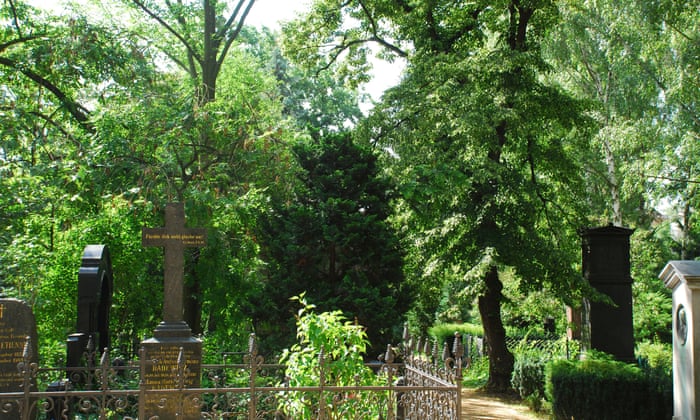Their Place In History
"I'm just happy that there is now this place."
"We Always drove with my sons to Ploetzensee, but that is really a place of execution even if it is not what it was then, and I'm glad I can come here now."
Saskia von Brockdorff, 81, Berlin
"The Nazis worried that the graves of the resistance fighters could become martyrs' cemeteries, so to speak, and they wanted to avoid this."
"It was clear they were involved in the resistance and were executed for their activities."
"Now we can give those murdered back their dignity."
Johannes Tuchel, director, German Resistance Memorial Center
 |
| The Dorotheenstaedtischer Cemetery |
Over 2,800 people -- during the days of the Third Reich when Nazis threatened the world order with their intention to command the world as Teutonic ubermenschen, and planned to enslave all those they considered inferior (untermenschen) while at the same time conducting a widespread, organized genocide of European Jews, Gypsies, Homosexuals, and the physically and mentally 'deficient' -- who courageously defied the Nazis and actively worked to overthrow the regime were executed at the Ploetzensee prison by guillotine or hanging.
Their bodies were to be destroyed to prevent them from being buried as would ordinarily be done, for fear that their places of burial would become a shrine, visited by those who secretly supported them, clearly enemies of Hitler's Thousand-Year ambitions for Germany. But minuscule portions of the bodies of some of those who were executed were identified and a ceremony of partial remains of 300 Nazi resistance fighters finally found a home in a downtown Berlin cemetery.
All the pieces of human tissue were placed within a small wooden box. A square, granite-edged plot had been prepared and into it the wooden box was lowered for burial, during a ceremony that brought, among other mourners Saskia von Brockdorff, the daughter of Erika von Brockdorff, beheaded in Ploetzensee Prison 76 years ago for being involved in the Red Orchestra resistance movement. A small group of people assembled to pay their respect.
 |
| The remains will be buried at the Dorotheenstadt cemetery, in Berlin. Photograph: Alamy |
Close by stands a memorial to the leaders of the failed 1944 plot that attempted to assassinate Adolf Hitler. Some of those present at the ceremony sprinkled dirt over the grave, others laid flowers and prayed silently over the interment of the tissue fragments whose presence was discovered two years earlier by descendants of the former director of the Berlin Institute of Anatomy at the Charite hospital, Hermann Stieve.
According to Johannes Tuchel, who was involved in the investigation into the human remains and organized their burial, Dr. Stieve, not a member of the Nazi party, found it nonetheless useful to arrange that the bodies of the executed be placed in his care for research. He promised, when he dealt with the Nazi authorities who agreed to his request, that he would ensure no trace of their bodies would be left for posterity.
It was the bodies of the women who were executed that Dr. Stieve was interested in for his research focusing on menstrual cycles. Like Dr. Josef Mengele, the infamous Angel of Death at Auschwitz who had free rein to conduct experiments on Jews and Roma with his especial interest on studying children and twins, Dr. Stieve had a major interest in studying the effect of stress on menstruation. Dr. Mengele was responsible for placing his victims in horrible research amounting to torture leading to death.
It appeared to bother Dr. Stieve not one iota that his research subjects had been executed; clearly, he like Mengele felt their research was more important than considerations of sustaining human life. Both wrote scholarly medical articles describing their experiments, the outcomes and conclusions, and both felt their academic professional credentials placed them above any criteria in observation of criminal abuse of human lives.
Dr. Stieve's heirs' discovery of the tissue samples reflected their obligation to history and humanity when they made it known that they were in receipt of the remains of women between the ages of 20 to 40. It is an open secret that the findings of the research conducted by butchers such as Mengele were studied and used by the medical community in years following the conclusion of the Second World War. Doubtless Dr. Stieve's findings contributed as well to the medical canon.
Relatives of those buried were present at the ceremony that took place in the small chapel at the Dorotheenstaedtischer Cemetery. It was a multi-denominational service conducted by Protestant and Catholic priests along with a Jewish rabbi, preceding the burial.
 |
Labels: German Freedom Fighters, Medical Experiments, Nazi Germany, World War II
0 Comments:
Post a Comment
<< Home